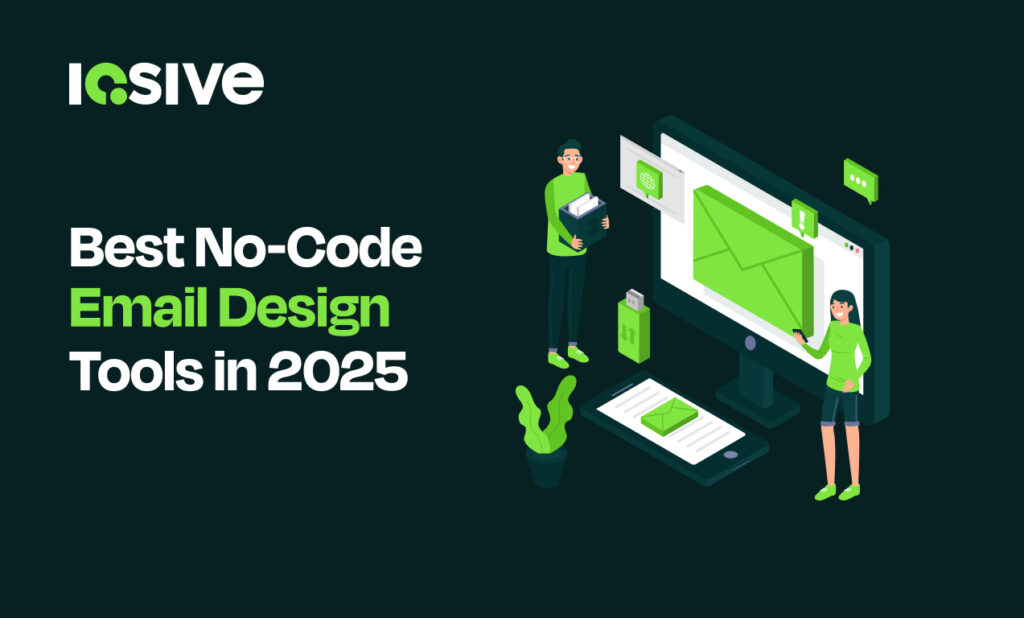In 2025, email marketing remains one of the highest ROI channels across industries. But while the strategy is sound, execution is often bottlenecked by design complexity or lack of development resources. No-code email design tools solve this by enabling marketers, founders, and small teams to build beautiful, high-converting emails without writing a single line of HTML..
This guide explores the best no-code email design platforms in 2025, their strengths and limitations, and how to choose one based on your business needs. Whether you run an ecommerce store, a SaaS platform, or a content-based business, you’ll walk away with practical insights to power your next campaign.
What Makes a Great No‑Code Email Design Tool?
Key Features to Look For in 2025
In 2025, standout no-code tools go beyond drag-and-drop functionality. The best platforms now offer:
- AI-assisted design: Tools like Bee and Stripo now auto-suggest layouts based on your goal (e.g., product launch vs. re-engagement).
- Modular content blocks: Reusable components that allow for consistent branding across campaigns.
- Built-in testing suites: Ensure mobile responsiveness, inbox rendering, and spam-checking before send.
- Dynamic content support: Easily personalize content by location, behavior, or user segment.
- ESP compatibility: One-click exports to platforms like Mailchimp, Klaviyo, or HubSpot.
Benefits of Drag‑and‑Drop Email Builders
No-code editors democratize email design, enabling:
- Speed: Build campaigns in minutes, not hours.
- Accessibility: Non-designers can create pixel-perfect layouts without relying on dev or creative teams.
- Consistency: Maintain brand voice and visual identity through saved blocks and templates.
- Collaboration: Most tools offer multi-user editing, comments, and approval workflows.
Common Limitations and Workarounds
While powerful, no-code tools aren’t without limits:
- Custom coding constraints: Advanced HTML or AMP support may be restricted.
Workaround: Choose platforms like Stripo that allow code editing within the builder.
- Export headaches: Some tools lock templates into proprietary formats.
Workaround: Look for platforms that offer raw HTML export.
- Limited A/B testing: Builders may lack robust experimentation tools.
Workaround: Use your ESP’s testing features or integrate with analytics platforms like Litmus or Google Optimize.
Top No‑Code Email Design Tools for 2025
Bee (formerly Beefree)
Bee continues to lead the space with its clean interface, responsive templates, and export flexibility. It’s especially strong in visual customization and offers a wide variety of professionally designed blocks. Bee Pro also allows for role-based team collaboration.
Stripo
Stripo shines for advanced users. It supports AMP, dynamic blocks, and direct integration with over 70 ESPs. It’s ideal for businesses that want both drag-and-drop simplicity and the ability to tweak code behind the scenes.
MailerLite
A favorite for small businesses, MailerLite includes a solid email builder within its broader email marketing platform. Its standout features include ecommerce integrations and automated workflows, all at a price point accessible to solo creators.
Moonsend
Moonsend offers a polished visual editor with a focus on automation and behavioral triggers. It’s well-suited for marketers who want powerful automation alongside a solid no-code design experience.
Mailchimp
Mailchimp remains a market staple. In 2025, its builder has improved with better content blocks, AI-powered copy suggestions, and multi-step automation tools. It’s a one-stop shop for email creation, audience segmentation, and reporting.
Postcards by Designmodo
Best for designers, Postcards provides ultra-modern, modular templates and an intuitive UX. While it lacks some automation features, its export flexibility and design polish make it perfect for freelancers or agencies.
Comparing the Best Email Builders Side-by-Side
Usability and Learning Curve
- Easiest to use: MailerLite and Bee
- Most flexible: Stripo and Postcards
- Best for teams: Bee Pro and Mailchimp
Template Quality and Responsiveness
- Top visual design: Postcards and Bee
- Mobile performance: Stripo and Mailchimp rank highly in mobile inbox rendering tests (source: EmailToolTester, 2025).
Integrations and Export Options
- Bee and Stripo offer native integrations with 50+ ESPs.
- Mailchimp, being an all-in-one solution, doesn’t require export.
- Postcards offers raw HTML exports for advanced users.
Pricing and Scalability
- Best free tier: MailerLite
- Best for growing teams: Bee Pro
- Enterprise-ready: Mailchimp and Stripo
How to Choose the Right Tool for Your Business
For Ecommerce and DTC Brands
Look for tools with ecommerce integrations (like Shopify or WooCommerce), abandoned cart blocks, and dynamic product content. Bee and Mailchimp are excellent here.
For Freelancers and Small Agencies
You need flexible design and easy collaboration. Postcards offers client-friendly exports, while Bee allows shared workspaces and feedback loops.
For Enterprise or Multi-Team Collaboration
Choose tools that offer version control, approval workflows, and role-based access. Mailchimp and Bee Pro scale well for large teams working across campaigns.
Best Practices for High-Converting Email Templates
Mobile-First and Responsive Design
With over 70% of email opens on mobile (Litmus, 2025), your design must adapt to small screens. Use single-column layouts, tappable CTAs, and avoid large image files.
Personalization and Dynamic Content
Emails with personalized subject lines are 26% more likely to be opened. Use merge tags and conditional blocks to tailor content by behavior, name, or purchase history.
CTA Placement and Visual Hierarchy
Keep one clear CTA per email. Place it “above the fold” on mobile, use contrasting colors, and surround it with whitespace to drive clicks.
A/B Testing and Optimization
Test subject lines, CTA wording, image placement, and send times. Most ESPs allow simple split tests. Combine this with heatmaps or engagement tracking for deeper insights.
Final Thoughts: Are No‑Code Email Tools Worth It in 2025?
Absolutely. No-code email builders have matured into full-fledged design systems that empower marketers of any skill level to create effective, conversion-driven campaigns. In 2025, the best tools combine ease of use with deep customization, enabling fast turnarounds without sacrificing brand quality or performance.
Whether you’re a solo founder or part of a large team, there’s a platform that fits your workflow, budget, and campaign goals. By choosing wisely and following best practices, you’ll set yourself up for email success in the months and years to come.
FAQs:
Q1: What is the best free no‑code email design tool in 2025?
MailerLite offers one of the most generous free tiers, ideal for small lists and growing businesses without compromising on core features.
Q2: Are drag‑and‑drop email editors mobile-friendly?
Yes, most modern editors use responsive frameworks that auto-adjust for mobile devices. Always preview your design on mobile before sending.
Q3: Can I export emails from no‑code tools to my ESP?
Yes. Tools like Bee, Stripo, and Postcards support HTML export or native integrations with platforms like Mailchimp, HubSpot, and Klaviyo.
Q4: Which email builder is best for ecommerce brands?
Bee and Mailchimp are top choices due to their dynamic content capabilities, ecommerce integrations, and product recommendation blocks.
Q5: How do drag‑and‑drop email builders improve conversions?
They enable rapid testing, consistent branding, and intuitive layouts key factors in improving click-through rates and engagement.
Q6: What’s the difference between Bee and Stripo?
Bee is better for ease of use and team collaboration; Stripo is more advanced, offering AMP support and deeper customization for developers.
Q7: Are no‑code email tools secure for large organizations?
Yes, most reputable platforms offer GDPR compliance, data encryption, and enterprise-grade security features.
Q8: Do these tools support AMP or interactive emails?
Only a few do Stripo leads the pack in AMP support, allowing carousels, forms, and live content directly in the inbox.
Q9: What are some common mistakes when using email builders?
Overloading with images, poor mobile optimization, inconsistent branding, and neglecting pre-send testing are common pitfalls.
Q10: Can I create branded email templates without coding skills?
Absolutely, No-code builders allow you to save and reuse branded blocks, import logos, and apply brand colors without touching code.









